What Does A Female Bigfoot Look Like?
Posted by: Loren Coleman on April 5th, 2008
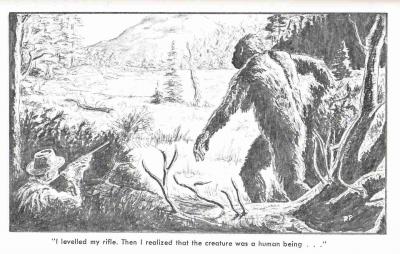
The above drawing of the William Roe encounter’s Sasquatch was used to illustrate Ivan T. Sanderson’s men’s magazine article detailing Roe’s sighting. From the initials of the artist in the right hand corner, they do not appear to match Morton Kunstler’s.
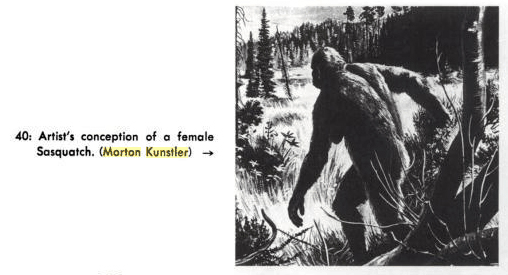
The closeup of the Roe drawing done by Kunstler in Sanderson’s 1961 ABSM book seems to have been based on the above sketching (but they are different).
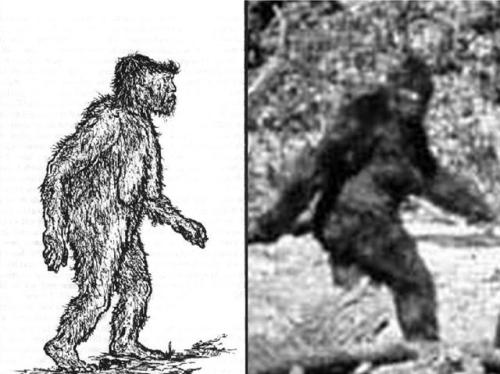
The image on the left is usually noted as Roger Patterson’s drawing of the “Old Woman” of the 1924 Albert Ostman encounter. But most drawings in Patterson’s book are reproductions from others’ Bigfoot works. Was Patterson merely copying some version he first saw published elsewhere?

Daniel Loxton, editor of Junior Skeptic magazine, wrote to Cryptomundo on April 24, a year ago: “It’s the Roe sketch that suggests itself most strongly as Patterson’s inspiration…” for the female Bigfoot in the famed 1967 Bluff Creek footage.
What do you think?

This Willian Roe drawing was done in 1958, by his daughter from his description of what he said he saw in 1955, in British Columbia.
One has to wonder if Loxton just can’t get beyond the breasts of the Roe Sasquatch?
Did any of you catch the curl on the brow of the Albert Ostman Old Woman drawing by Roger Patterson? That curly description by Ostman is the inspiration for Ivan Sanderson’s own drawing of Sasquatch (not shown), and the Jim McClarin statue’s browridge (directly below), as well.
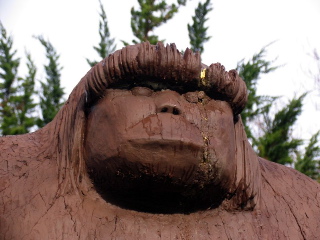
Here, take another look:

Was it the William Roe drawing by Morton Kunstler in True Magazine that actually serves as the model for the Bigfoot suit that no one can produce? Kunstler’s illustration shows the hint of a breast, the almost classic Patterson-Gimlin swinging of the arms, and even the famous black line down the back.
Or was William Roe describing a real unknown primate that is merely confirmed with the filming of a similar female hairy hominoid 12 years later?
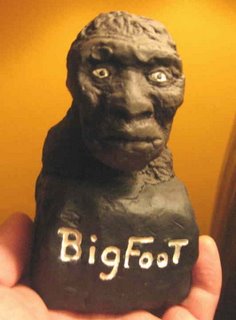
Roger Patterson’s Bigfoot bust sculpture was copied by David Murphy. What can we tell from the face of Bigfoot shown here?
About Loren Coleman
Loren Coleman is one of the world’s leading cryptozoologists, some say “the” leading living cryptozoologist. Certainly, he is acknowledged as the current living American researcher and writer who has most popularized cryptozoology in the late 20th and early 21st centuries.
Starting his fieldwork and investigations in 1960, after traveling and trekking extensively in pursuit of cryptozoological mysteries, Coleman began writing to share his experiences in 1969. An honorary member of Ivan T. Sanderson’s Society for the Investigation of the Unexplained in the 1970s, Coleman has been bestowed with similar honorary memberships of the North Idaho College Cryptozoology Club in 1983, and in subsequent years, that of the British Columbia Scientific Cryptozoology Club, CryptoSafari International, and other international organizations. He was also a Life Member and Benefactor of the International Society of Cryptozoology (now-defunct).
Loren Coleman’s daily blog, as a member of the Cryptomundo Team, served as an ongoing avenue of communication for the ever-growing body of cryptozoo news from 2005 through 2013. He returned as an infrequent contributor beginning Halloween week of 2015.
Coleman is the founder in 2003, and current director of the International Cryptozoology Museum in Portland, Maine.










By looking at Roe’s drawing, it looks like someone heard the word “female” and drew what he wanted to see. That there is almost the perfect human female (minus the ape face). The back of the skull/neck (no distinction between them) look like she should have long, flowing locks of hair. The chest is just too perky for her to be from the wild.
Patterson’s looks more like his footage, just a little on the skinny side.
I’m not sure about that bust. There are parts of it that look more human than ape. To be more specific (and no offense to anyone, please) it looks to be of African human descent. Everything except the forehead and the top of its head looks human.
A few weeks back on A&E TV’s new series, “Paranormal State” the star and narrator of the show, Ryan Buell, made the statement that “it has been proven that Bigfoot is a myth”. That got my attention. I wonder where he got his information from? And it has not, to my knowlege, been “proven” to be a myth. Did anyone else manage to catch that? Thanks.
To my mind, the question is not: does Patterson’s bigfoot resemble Roe’s sketch. After all, it would be very difficult to manufacture a filmed image replica based on a drawing. Instead, I suggest the Patterson film is based on the Roe ACCOUNT; hence, the breasts, the over the shoulder glance, the unhurried gait, etc. It is almost as if Roe’s account was the screenplay and Patterson’s film the adaptation.
The real question: if Roe and Patterson saw the same animal, why does Roe’s sketch not look more like Patterson’s bigfoot?
“The real question: if Roe and Patterson saw the same animal, why does Roe’s sketch not look more like Patterson’s Bigfoot?”
I can’t imagine anyone would seriously consider “it” is the same specific animal, as the Roe sighting occurred in British Columbia, and then 12 years later, the Patterson-Gimlin encounter took place in northern California.
Individual variation and differences in ages in the two Bigfoot females being seen would easily explain why an exact match would not have occurred. Also, the Roe sighting is only known from drawings, which naturally have to go through the screen of human interpretation and the P-G image is photographic in nature.
“”Patterson’s looks more like his footage, just a little on the skinny side.””
I see almost nothing very similar in that drawing by Patterson. The drawing by Patterson looks almost human with sparse hair covering and (as you say) skinny/spindly limbs. It doesn’t look ‘apelike’ in any way (in my opinion).
The Roe drawing looks more like the P/G footage than the Patterson drawing does.
“The real question: if Roe and Patterson saw the same animal, why does Roe’s sketch not look more like Patterson’s bigfoot?”
Um, jerrywayne, that’s not a serious question. For one thing, how could you expect Roe’s sketch to “follow” something that wasn’t going to appear for a dozen more years?
For another: Roe’s sketch (which isn’t Roe’s but done by his daughter under his direction) is a SKETCH, a second-hand account for all intents and purposes. Answering shumway’s criticism, it would be expected to reflect a human female in some respects; the animal’s bipedal; the only reference point in 1955 WAS human females (unless you want to count gorillas), and, again, it was a SKETCH. Done by a human, secondhand, of a human-like animal. And reflecting a very naive view, supplemented by limited artistic competence. (If I saw one, I wouldn’t draw one nearly that good. Wouldn’t mean I didn’t see it; it would mean I CAN’T DRAW WORTH NUTHIN’.)
And it’s pretty obvious to me, given that it’s a SKETCH, that the REAL question is: why would you think the Roe SKETCH and the Patterson film are so SIMILAR?
Different individuals of the same species, one rendered secondhand as a SKETCH?
Occam would say so.
One thing that strikes me as very funny is how many skeptics swallow layman accounts whole, without criticism. One person can see a face and say: ape! Gorilla! Another can see the same one and say, as one did: “scarily human…I don’t feel comfortable using the word ‘ape’ to describe it.”
Those descriptions, actually, don’t vary at all; they are subjective responses, usually by people who haven’t seen too many apes firsthand, to something like they’ve never seen before.
Kind host,
You are correct. What I meant, of course, was: the same type animal. However, the Roe image, as well as the Ostman image, always reminded me more of a monkey like animal, rather than an ape.
There are elements of the Kunstler interpretation that are echoed in the Patterson film.
If we suggest Patterson’s film is a hoax, then we should deconstruct the film image he created. What was “in the air” at that time which influenced Patterson. For one thing, the Roe sketch is not as close a match for Patterson’s bigfoot as is the Kunstler re-imagining. For instance, Kunstler’s image has a massive set of upper back muscles. This is reproduced in Patterson’s film, although Roe’s sketch and his testimony do not include such a feature.
Of coarse, if one believes Patterson filmed a relic, very large, bipedal ape, then the line of reasoning I’m pursuing is of no interest.
Relating to the Patterson film, someone here might be able to answer my question.
When the Patterson account and film stills first appeared in Argosy magazine, I was facinated and looked at the image a thousand times. One thing had me puzzled: the creature’s face. It was very indistinct, reflecting the sunlight, and for an odd reason, did not seem apelike to me.
Of course, the object was filmed at such a distance that indistinct facial features were to be expected.
Over the years I began to notice various reproductions that included facial features. Some were obviously air brushed features, very apelike. Some reproductions seemed more like computer enhancements or maybe even computer generated images. Does anyone know why, when and how Patterson’s bigfoot began to show clear facial features?
And while I’m asking questions, let me ask one more. In Napier’s bigfoot book, he states that he believes there might a bigfoot in America. But, he warns, and I paraphrase, it probably won’t be what it is cracked up to be. What did he mean by that? Any ideas?
DWA,
The Roe image and the Patterson image are supposed to be of the same type of animal, a female bigfoot. I don’t think they look that close, even given hypothesized differences in age and individual variations. I made the point only to disassociate Patterson’s image from Roe’s sketch (a sketch made under his supervision). I wanted to suggest that it was not Roe’s sketch that influenced Patterson’s image (if we take the film to be a hoax), but rather Roe scenario, which does closely match Patterson’s.
I’ve always been intrigued by the fact that Roe’s and Patterson’s creatures were so obviously female. It is still my contention that Ostman’s story was based on Roe’s, with just more facts added to make it more interesting. I enjoyed this discussion. As for the curly brow ridges, that has always been a question of mine too. It is quite noticeable when you see Jim’s statue in person.
jerrywayne,
I can’t vouch anything for anything anyone may or may not have done with the P/G film. All that I know is this: the basic description of what they saw on the film, given by scientists who analyzed the original film and come down on it as genuine, seems to generally comport with what I see. And this has nothing to do with facial features. It has everything to do with the figure’s proportions and gait, things that strike me as humanlike, but not human, and struck them the same way. I do think that too many (harrumph, M.K. Davis, although thanks for stabilizing it) have tried to read too much into something that truthfully doesn’t need it; Patty is no blobsquatch.
And I’m not really sure – and never have been – where Napier is coming from on the film, particularly since he seemed to come down on the conclusion that there was an undocumented animal out there even if Patty, to him, wasn’t it. My understanding is that he thought half of Patty looked like a human and half like an ape, and he just didn’t think that happened in nature. Barbara Wasson took him over the coals for that evaluation, and rightly so; it’s a totally subjective read. It’s like my saying the duck-billed platypus can’t be a mammal because it has a head like a bird. And it is very like the subjective evaluations of sighters, some of whom see an ape in the face, some of whom see a human, and some of whom see a mix. It’s a sasquatch. What people see in it comes at least in part from the baggage they bring to the sighting. When I first saw an orangutan face close up in a photo I thought: THAT IS A PERSON! When I first saw the “First Child” (Australopithecus afarensis three-year-old) on the cover of National Geographic, I thought: that’s an orangutan. Approximately 40 years – and a lot of accumulated knowledge, but, yes, baggage too – separated the two reads.
And as to the Roe drawing, that looks a LOT like the P/G animal to me. Remember: we’re not just talking about “hypothesized differences in age and individual variations.” As I noted above, and Loren did too: IT IS A SKETCH! And not, I can tell you right off the top of my head, a sketch by any kind of gifted artist. If I gave someone frame 352, and the Roe drawing is what they came up with as a representation, I would consider them to have drawn what is on that film, AS BEST THEY COULD. (Copying the pose, well, would be nice.)
A drawing gives you something. But it is the difference between hearsay and being there.
DWA.
Your comment about the difference in a sketch and film is well taken. Perhaps my big gripe is that the Roe sketch does not reproduce the bulk or the posture of the “animal” represented in the Patterson film.
Napier, if I remember right, believed the Patterson creature had features of both a male and female primate (the sagittal crest of a male gorilla, the female breasts of a human). To him, this suggested a hoax by someone not too familiar with primate anatomy (and, I wouldn’t write off such a view as merely subjective). He also thought Patterson’s subject walked in a self conscious way, like a man stepping off yards.
Napier, however, believed that there was something to bigfoot accounts because there were so many people who claimed to have seen such an animal. But, he also concluded, when the mystery is solved, it will not be all it was cracked up to be. And this comment has always, always baffled me.
(Also, Napier was the first person I know of who noted the significance of the fact that bigfoot tracks were of two different types, one more human like, the other a “hour glass” like shape. This led him to suspect hoaxing, or else there were two distinct species of bigfoot).